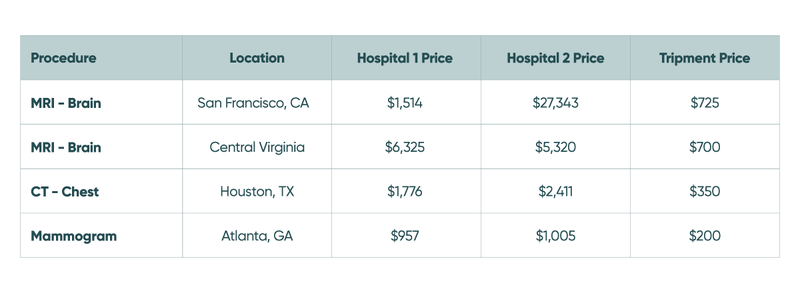
How to Get Affordable Diagnostic Imaging
Diagnostic imaging tools (MRI, CT scan, X-ray, mammogram, etc.) are frequently used to assist a physician with confirming or ruling out a particular diagnosis. A few imaging services, such as the mammogram and X-ray, are also used as part of preventative care to help catch any ailments early.
Most Americans are under the assumption that in order to obtain an imaging scan you first need health insurance, a referral, and an appointment set by a physician. This is actually not the case. Many imaging centers are structured to be able to offer a flat rate for various scans eliminating the strict guidelines set by insurance companies and ultimately passing the savings on to the patient. Frequently, these flat rates are significantly lower than what the insurance company or hospital will charge you for the exact same service.
Cost Savings With Diagnostic Imaging
Many people with private insurance believe they are at the mercy of their physician as to where they can obtain the scans and images they have been referred for. The National Bureau of Economic Research (NBER) reports that referring physicians heavily influence where patients receive care, and if the physician is vertically integrated with hospital systems and insurance companies then patients are more likely to receive higher priced hospital-based scans and imaging services.
The National Center for Health Statistics found in a 2016 survey that the number of Americans choosing the high deductible health insurance plan option within their employee-based insurance plan now stands at almost 40 percent. This means that your insurance doesn’t kick in until you meet the deductible, which in some cases can be over $8,000. This situation leaves many people paying out of pocket for high priced medical services that can be obtained cheaper by shopping around and paying cash.
For example, the below graph shows the recent cost difference between a hospital price vs. a flat rate price for the exact same procedure found on Tripment in the same geographic area.

“This is one of the dirty little secrets of healthcare,” Gerald Kominski, director of the UCLA Center for Health Policy Research told the Los Angeles Times in a 2016 article. “If your insurance has a high deductible, you should always ask the cash price.”
What is Diagnostic Imaging?
Diagnostic imaging is exactly what its name suggests. It uses internal images of your body to help diagnose various diseases, conditions, and injuries. The most common scans prescribed are non-invasive and can be done in an out-patient diagnostic imaging center.
The more detailed scans (MRI, CT) may be administered with or without contrast. Contrast is a substance that changes the way imaging tools interact with the body that improve the picture, and allow the radiologist to better distinguish abnormal from normal conditions. Contrast may be given orally, rectally, or through an IV depending on the body part being scanned and are usually either iodine based or barium-sulfate based.
Magnetic Resonance Imaging (MRI)
The MRI uses a magnet and radio waves to produce a highly detailed picture of internal organs, structures of your body, blood vessels, nerves, muscles, and soft tissues. The MRI is best for spotting:
- Cartilage loss
- Joint inflammation
- Nerve compression
- Spinal injuries
- Torn or detached ligaments, tendons, muscles and cartilage
The procedure, which may be administered with or without contrast, involves laying flat and completely still on a table as a tube-like cylinder rotates around the body. It is noted that this scan is very loud and may take from 15-60 minutes depending on the area being scanned.
Since MRIs involve a strong magnetic field, it is not advised for anyone with metal implants including a pacemaker, implantable pumps, metal plates or pins, history of bullet wounds.
Get checked now
Need an MRI?
An MRI can help your doctor diagnose a health issue, prescribe a treatment plan, or monitor progress.
Computerized Tomography Scan (CT Scan)
A CT scan uses X-ray and radiation technology to capture detailed 360 degree images of any body part including the bones, muscle, fat, organs, and blood vessels. The CT scan, which can be administered with or without contrast, is best for spotting:
- Blood clots
- Bone fractures, including subtle fractures not visible on X-ray
- Organ injuries
Similar to the MRI, the CT scan requires the person to lay on a flat table and remain completely still while the machine rotates around them. Clicking sounds will be heard and the patient and technician have the ability to communicate with each other through speakers. The CT scan usually only takes a couple of minutes to complete.
Get checked now
Need a CT scan?
A CT scan is a noninvasive way to detect abnormalities in soft tissue, blood vessels, and bones.
X-ray
X-rays are the fastest and most accessible form of imaging. It uses radiation to capture images of bones and teeth that allow physicians to quickly determine if there is an abnormality. X-rays are best suited for spotting:
- Fractures
- Dislocations
- Misalignments
- Narrowed joint spaces
X-rays use simple technology and don’t have the ability to identify subtle bone injuries, inflammation, soft tissue damage, or other more detailed information that an MRI or CT scan can produce.
Get checked now
Need an X-ray?
An X-ray can help your doctor diagnose a health issue, prescribe a treatment plan, or monitor progress.
Mammogram
A mammogram uses X-ray technology to capture an image of the breast that can help diagnose problems such as lump, pain, discharge, cancers, benign tumors, and cysts before they become detectable through touch. A mammogram can’t diagnose breast cancer, but if an abnormality is present, then physicians can do a biopsy of the suspected tissue for further evaluation.
A screening mammogram is used to detect breast changes in women who do not have any signs or symptoms. This is usually done as an annual preventive care screening for women aged 40 and above.
A diagnostic mammogram is used to investigate symptoms of breast changes including pain, lumps, and discharge. It is also used to further evaluate any abnormal findings obtained during a screening mammogram.
Get checked now
Need a Mammogram scan?
An Mammogram scan can help your doctor diagnose a health issue, prescribe a treatment plan, or monitor progress.
Mammogram - Diagnostic
from$168
Book nowMammogram - Screening
from$120
Book now
Making Healthcare More Transparent
Healthcare costs and the confusion that surrounds medical bills has historically been the norm in America. As we move into a new year, hopefully both technological advances and policy changes can lead to a transparent marketplace for various medical procedures and services that can help eliminate the need for families to juggle their expenses between quality medical care and other life essentials.
At
Tripment, we believe that healthcare can be done better, and it starts with price transparency and healthcare consumerism. Contact us to learn more about the services we provide to enable you to find local diagnostic imaging services at a reduced flat rate that allow you to compare prices before you make your appointment.
Sources:
- https://www.nber.org/system/files/working_papers/w24869/w24869.pdf
- https://www.investopedia.com/terms/v/verticalintegration.asp
- https://www.cdc.gov/nchs/data/nhis/earlyrelease/ERHDHP_Access_0617.pdf
- https://www.healthcare.gov/glossary/high-deductible-health-plan/
- https://www.latimes.com/business/lazarus/la-fi-lazarus-healthcare-pricing-20160610-snap-story.html
- https://www.radiologyinfo.org/en/info.cfm?pg=safety-contrast
- https://www.hopkinsmedicine.org/health/treatment-tests-and-therapies/magnetic-resonance-imaging-mri
- https://www.hopkinsmedicine.org/health/treatment-tests-and-therapies/computed-tomography-ct-scan
- https://www.hopkinsmedicine.org/health/treatment-tests-and-therapies/xrays
- https://www.hopkinsmedicine.org/health/treatment-tests-and-therapies/mammogram-procedure
 Amy Isler, RNWhat’s in a Title: Different Types of Healthcare Providers & What They DoChoosing an experienced primary care physician is an important decision that can be both intimidating and confusing. In your search, you will probably come across providers who have different titles and hold different licenses and certifications that you may not fully understand.
Amy Isler, RNWhat’s in a Title: Different Types of Healthcare Providers & What They DoChoosing an experienced primary care physician is an important decision that can be both intimidating and confusing. In your search, you will probably come across providers who have different titles and hold different licenses and certifications that you may not fully understand. Amy Isler, RNWhat Is Direct Primary Care & How Does it Work?Direct Primary Care utilizes the subscription/membership platform that many have become familiar with over the past several years and applies it to the healthcare setting, where primary care physicians charge their patients a monthly, quarterly, or annual subscription or membership fee.
Amy Isler, RNWhat Is Direct Primary Care & How Does it Work?Direct Primary Care utilizes the subscription/membership platform that many have become familiar with over the past several years and applies it to the healthcare setting, where primary care physicians charge their patients a monthly, quarterly, or annual subscription or membership fee.